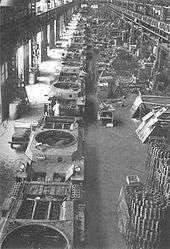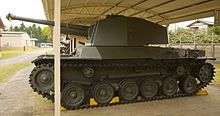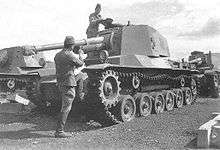Type 3 Chi-Nu
| Type 3 Chi-Nu | |
|---|---|
|
A Type 3 Chi-Nu at the JGSDF Ordnance School in Tsuchiura, Japan | |
| Place of origin | Empire of Japan |
| Production history | |
| Designed | 1943 |
| Produced | 1944–1945 |
| Number built | 144 to 166[1][2] |
| Specifications | |
| Weight | 19 tonnes (21 tons)[3] |
| Length | 5.64 m (18 ft 6 in) |
| Width | 2.41 m (7 ft 11 in) |
| Height | 2.68 m (8 ft 10 in) |
| Crew | 5 |
|
| |
| Armor | 12–50 mm |
Main armament | Type 3 75 mm tank gun (L/38) |
Secondary armament | 1 x 7.7 mm Type 97 machine gun |
| Engine |
Mitsubishi Type 100 |
| Suspension | Bell crank |
Operational range | 210 km (130 mi) |
| Speed | 39 km/h (24 mph) |
Type 3 Medium Tank Chi-Nu (三式中戦車 チヌ San-shiki chū-sensha Chi-nu) ("Imperial Year 2603 Medium tank Model 10") was a medium tank of the Imperial Japanese Army in World War II. It was an improved version of the Type 97 Chi-Ha, incorporating a Type 3 75 mm tank gun, one of the largest Japanese tank guns during the war.
The Chi-Nu did not see combat during the war. All produced units were retained for the defence of the Japanese Homeland in case of an Allied invasion.
History and development
At the outbreak of the Pacific War, the Type 97 Chi-Ha and Type 95 Ha-Go designs comprised the mainstay of the armored units of the Imperial Japanese Army. As the war progressed, these tanks started to face significant challenges posed by Allied tanks. In the Burma and Philippines Campaigns, the firepower of the 57 mm cannon mounted on the Type 97 was proven to be insufficient against Allied tanks. The Imperial Japanese Army therefore developed the Type 1 47 mm tank gun which had higher armor penetrating power. This gun was mounted on Type 97 Shinhoto Chi-Ha and Type 1 Chi-He medium tanks.
At the later stage of the war, large numbers of American M4 Sherman tanks arrived at the front line and put new pressure on Japanese armored forces. The Imperial General Headquarters (大本営 Daihon'ei) decided to develop a new tank to counter the enemy threat as well as a replacement for the Type 97 and Type 95.
The Army Technical Bureau had been working on the Type 4 Chi-To medium tank as the counter to the M4 Sherman, but there were problems and delays in the program. As a result a stopgap tank was required. The Type 3 medium tank Chi-Nu was developed to cope with the M4 Sherman.[4] Work on the Type 3 Chi-Nu started in May 1943 and was finished by October. The low priority given to tank production by 1943 meant that the Type 3 did not actually enter production until 1944, by which time raw materials were in very short supply, and much of Japan's industrial infrastructure had been destroyed by American strategic bombing.[5]

A total of 144 to 166 units were produced by the war's end.[1][6] The Type 3 Chi-Nu was the last tank that was fielded by the Imperial Japanese armed forces, and was still in production at the end of the war.[4]
Design
Armor and Protection

The Type 3 Chi-Nu retained the same chassis and suspension of the Type 1 Chi-He, but with the addition of an enlarged turret ring for the large new hexagonal gun turret with a commander's cupola.[7][8] It was the last design that based directly on Type 97 lineage.[9]
Armament
The main armament of the Type 3 Chi-Nu was the 75 mm Type 3 tank gun. The gun could be elevated between -10 and +25 degrees. Firing a shell at a muzzle velocity of 680 m/s (2,200 ft/s) it gave an armor penetration of 90 mm (3.5 in) at 100 m (110 yd) and 65 mm (2.6 in) at 1,000 m (1,100 yd).[10][11] Later APHE shells (695 m/s) were available giving the gun 100 mm (3.9 in) of penetration at 500 m.
Mobility
The Chi-Nu used a lever system rather than a handle system. It had the same engine as the Chi-He, producing 240 hp and a top speed of 38.8 Kph.[12]
Service record
The Type 3 was allocated to the Japanese home islands to defend against the projected Allied Invasion. They were to be part of the "Mobile Shock Force" to be used for counter-attacks.[13] As the surrender of Japan occurred before that invasion, the Type 3 was never used in combat.[14] The 4th Tank Division based in Fukuoka on Kyushu had a "significant" number of the Type 3 tanks which had been produced at its depot by the end of the war.[15]
One surviving Type 3 medium tank is on display at the Japan Ground Self-Defense Force Military Ordnance Training School at Tsuchiura, Ibaraki, Japan.
Variants

- Type 3 Chi-Nu Kai prototype
- One Chi-Nu was armed with the Type 5 75 mm tank gun (L/56.4) and a Type 4 Chi-To turret. The test was successful.[16]
See also
Tanks of comparable role, performance, and era
- Australian Sentinel
- British Cromwell
- Canadian Ram II
- German Panzer IV
- Hungarian Turán III
- Italian Carro Armato P 40
- Soviet T-34
- Swedish Stridsvagn m/42
- United States M4 Sherman
Notes
- 1 2 Zaloga 2007, p. 22.
- ↑ Taki's Imperial Japanese Army: Type 3 Chi-Nu Retrieved 29 September 2015.
- ↑ Hara 1972, p. 18
- 1 2 Taki's Imperial Japanese Army: "Tanks after Chi-Ha" Retrieved 2 May 2016.
- ↑ Tomczyk 2005, p. 3.
- ↑ Taki's Imperial Japanese Army: Type 3 Chi-Nu Retrieved 2 May 2016
- ↑ Tomczyk 2005, pp. 3, 32.
- ↑ Hara 1972, p. 18
- ↑ Zaloga 2007, pp. 17, 21.
- ↑ Tomczyk 2005, pp. 3, 5.
- ↑ Taki's Imperial Japanese Army: "Tank Guns" Type 3 75mm Tank Gun
- ↑ For the Record: Type 3 Chi-Nu Retrieved 3 October 2014
- ↑ Rottman & Takizawa 2008, p. 16.
- ↑ Zaloga 2007, pp. 21, 22.
- ↑ Tomczyk 2005, p. 15.
- ↑ For the Record: Type 3 Chi-Nu Retrieved 3 October 2014
References
- Foss, Christopher (2003). Great Book of Tanks: The World's Most Important Tanks from World War I to the Present Day. Zenith Press. ISBN 0-7603-1475-6.
- Foss, Christopher (2003). Tanks: The 500. Crestline. ISBN 0-7603-1500-0.
- Hara, Tomio (1972). Japanese Medium Tanks. AFV Weapons Profiles No. 49.
- Rottman, Gordon L.; Takizawa, Akira (2008). World War II Japanese Tank Tactics. Osprey Publishing. ISBN 978-1846032349.
- Tomczyk, Andrzej (2005). Japanese Armor Vol. 4. AJ Press. ISBN 978-8372371676.
- Zaloga, Steven J. (2007). Japanese Tanks 1939–45. Osprey. ISBN 978-1-8460-3091-8.
External links
| Wikimedia Commons has media related to Type 3 Chi-Nu tank. |
